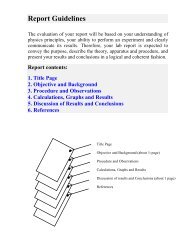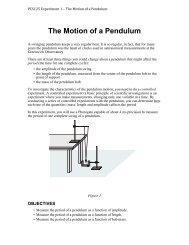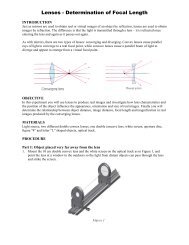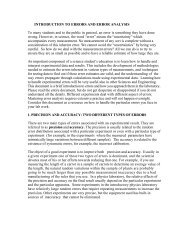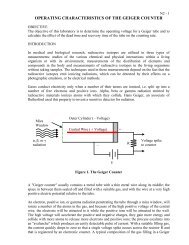Energy in Simple Harmonic Motion - Ryerson Department of Physics
Energy in Simple Harmonic Motion - Ryerson Department of Physics
Energy in Simple Harmonic Motion - Ryerson Department of Physics
You also want an ePaper? Increase the reach of your titles
YUMPU automatically turns print PDFs into web optimized ePapers that Google loves.
PCS125 Experiment 2 – The <strong>Simple</strong> <strong>Harmonic</strong> <strong>Motion</strong><br />
2. Compare your two energy plots to the sketches you made earlier. Be sure you compare to a<br />
s<strong>in</strong>gle cycle beg<strong>in</strong>n<strong>in</strong>g at the same po<strong>in</strong>t <strong>in</strong> the motion as your predictions. Comment on any<br />
differences.<br />
3. If mechanical energy is conserved <strong>in</strong> this system, how should the sum <strong>of</strong> the k<strong>in</strong>etic and<br />
potential energies vary with time Choose Draw Prediction from the Analyze menu and draw<br />
your prediction <strong>of</strong> this sum as a function <strong>of</strong> time.<br />
4. Check your prediction. Click on the y-axis label <strong>of</strong> the energy graph to choose another column<br />
for plott<strong>in</strong>g. Click on More and select the total energy column <strong>in</strong> addition to the other energy<br />
columns. Click to draw the new plot.<br />
5. From the shape <strong>of</strong> the total energy vs. time plot, what can you conclude about the conservation<br />
<strong>of</strong> mechanical energy <strong>in</strong> your mass and spr<strong>in</strong>g system<br />
EXTENSIONS<br />
1. In the <strong>in</strong>troduction, we claimed that the gravitational potential energy could be ignored if the<br />
displacement used <strong>in</strong> the elastic potential energy was measured from the hang<strong>in</strong>g equilibrium<br />
position. First write the total mechanical energy (k<strong>in</strong>etic, gravitational potential, and elastic<br />
potential energy) <strong>in</strong> terms <strong>of</strong> a coord<strong>in</strong>ate system, position measured upward and labeled y,<br />
whose orig<strong>in</strong> is located at the bottom <strong>of</strong> the relaxed spr<strong>in</strong>g <strong>of</strong> constant k (no force applied).<br />
2. Then determ<strong>in</strong>e the equilibrium position s when a mass m is suspended from the spr<strong>in</strong>g. This<br />
will be the new orig<strong>in</strong> for a coord<strong>in</strong>ate system with position labeled h. Write a new<br />
expression for total energy <strong>in</strong> terms <strong>of</strong> h. Show that when the energy is written <strong>in</strong> terms <strong>of</strong> h<br />
rather than y, the gravitational potential energy term cancels out.



